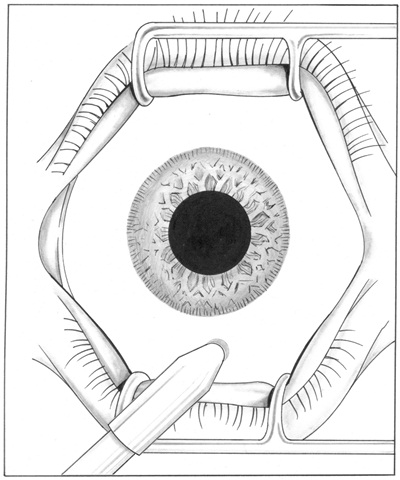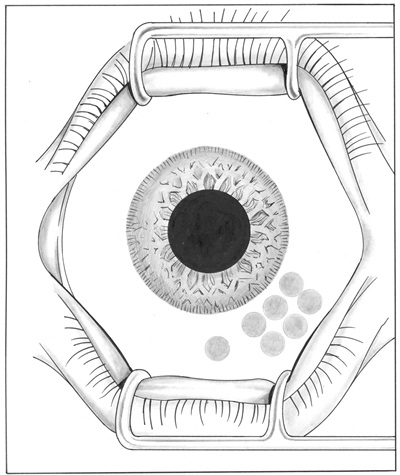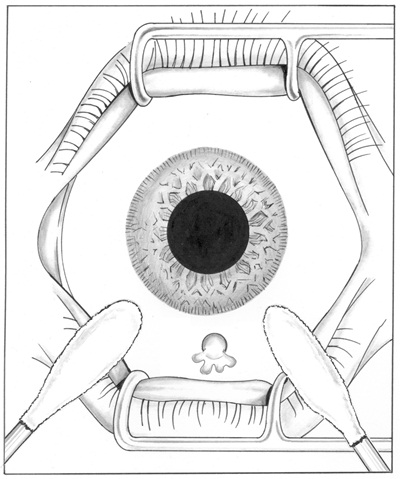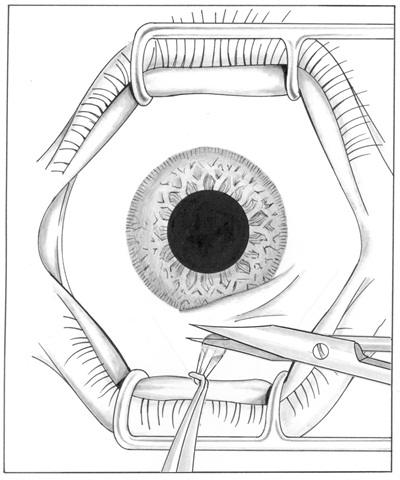Conjunctivochalasis and lymphangiectasia are similar-appearing conjunctival conditions that can be successfully treated with liquid nitrogen cryotherapy. This therapy probably works for both conditions by tacking down the conjunctiva to the underlying globe through a cryogenic burn. By creating an adhesion between the superficial conjunctiva and underlying Tenon's capsule and sclera, the symptoms and signs of these conditions are minimized.
Additionally, liquid nitrogen cryotherapy is probably effective in treating conjunctival lymphangiectasia by collapsing the lymph vessel walls onto each other through a cryogenic burn. Cryotherapy has been shown to kill endothelium of blood vessels, and the endothelium lining the large lymphatic vessels in conjunctival lymphangiectasia are damaged through the cryogenic burn.1
Liquid nitrogen cryotherapy has been proven safe and effective for conjunctival malignancies.2 It also appears to be efficacious in the treatment of multiple other benign ocular conditions, including benign conjunctival vascular tumors, advancing wavelike epitheliopthy,3 superior limbic keratoconjunctivitis,4 pterygia5 and conjunctival amyloidosis.6
Conjunctivochalasis and lymphangiectasia can be differentiated clinically and pathologically. However, subjective symptoms with either diagnosis may include epiphora, ocular irritation, eye redness and occasional blurred vision. The etiology of both conditions is unknown.
Current surgical treatment of conjunctivochalasis and lymphangiectasia is varied and includes: resection of the conjunctiva, replacement of resected conjunctiva with an amniotic membrane graft, electrocautery of redundant tissue, suturing remaining conjunctiva together to decrease redundancy, or using fibrin glue to hold down excess conjunctiva after resection.7,8
Lymphangiectasia is characterized by dilated and prominent lymphatic channels within the conjunctiva. The condition is usually unilateral unless associated with Turner syndrome or Nonne-Milroy disease.9
Conjunctivochalasis is a laxity of the bulbar conjunctiva that can occur inferiorly or superiorly. The condition is usually bilateral and can be asymmetric. Symptoms may include ocular dryness, pain and subconjunctival hemorrhage.10 Pathologic specimens reveal normal conjunctival epithelium and negligible inflammation and lymphocyte infiltration.2
The technique for treating conjunctival lymphangiectasia and conjunctivochalasis with liquid nitrogen cryotherapy involves performing a 1.5mm Brymill cryoprobe (Brymill Cryogenic Systems, Ellington, Conn.) using a double freeze-thaw method after an incisional biopsy of a portion of the conjunctiva. (See Figure 1.) Freeze times are one to two seconds, with thawing of five to 10 seconds in between treatments. Prior case series have demonstrated the effectiveness of this technique with a slightly different approach depending upon the diagnosis.1,6

Figure 1. Liquid Nitrogen cryotherapy with 1.5mm cryoprobe.
For treating conjunctivochalasis, a single incisional biopsy will suffice followed by multiple areas of cryotherapy. (See Figure 2.) If lymphangiectasia is the diagnosis, a strip of conjunctiva in the involved area may be necessary as the lymphatic fluid may not drain with simple marsupialization in a single area. (See Figure 3.)

Figure 2. Multiple areas of cryotherapy applied over the conjunctival lymphangiectasia.

Figure 3. Cotton swab-assisted expression of subconjunctival fluid.
The difference between the conditions can be tested by grasping the conjunctiva intraoperatively with 0.12 forceps to reveal a "tenting" phenomenon of loose conjunctiva, which is diagnostic of lymphantgiectasia. (See Figure 4.) In addition, one can usually see dilated lymphatic vessels clinically at the slit lamp with lymphangiectasia.

Figure 4. Tenting of the redundant conjunctiva prior to an incisional biopsy with Westcott scissors.
After treatment with liquid nitrogen cryotherapy, the symptoms and signs of each condition usually resolve within two weeks.
From Casey Eye Institute, Oregon Health & Science University, Portland, Ore. Send correspondence and reprint requests to F.W. Fraunfelder, MD, Casey Eye Institute, 3375 SW Terwilliger Blvd, Portland, OR 97239-4197. Phone (503) 494-4318, fax (503) 418-2284, e-mail eyedrug@ohsu.edu. This study was supported in part by an unrestricted grant to Casey Eye Institute from Research to Prevent Blindness, New York, N.Y.
References
- Fraunfelder FW. Liquid nitrogen cryotherapy of conjunctival lymphangiectasia: a case series. Arch Ophthalmol. 2009;127(12):1686-1687.
- Fraunfelder FT, Wingfield D. Management of intraepithelial conjunctival tumors and squamous cell carcinomas. Am J Ophthalmol. 1983;95:359-363.
- Fraunfelder FW. Liquid nitrogen cryotherapy of advancing wavelike epitheliopathy. Cornea. 2006;25(2):196-198.
- Fraunfelder FW. Liquid nitrogen cryotherapy of superior limbic keratoconjunctivitis. Am J Ophthalmol. 2009;147(2):234-238.
- Fraunfelder FW. Cryotherapy for pterygia. Ophthalmology. 2008;115(12):2314-2314.e2.
- Fraunfelder FW. Liquid nitrogen cryotherapy for surface eye disease (an AOS thesis). Trans Am Ophthalmol Soc. 2008;106:301-324.
- Kheirkhah A, Casas V, Blanco G, et al. Amniotic membrane transplantation with fibrin glue for conjunctivochalasis. Am J Ophthalmol. 2007;144(2):311-313.
- Meisler DM, Eiferman RA, Ratliff NB, Burns CD. Surgical management of conjunctival lymphangiectasis by conjunctival resection. Am J Ophthalmol. 2003;136(4):735-736.
- Perry HD, Cossari AJ. Chronic lymphangiectasis in Turner's syndrome. Br J Ophthalmol. 1986;70(5):396-399.
- Wang Y, Dogru M, Matsumoto Y, et al. The impact of nasal conjunctivochalasis on tear functions and ocular surface findings. Am J Ophthalmol. 2007;144(6):930-937.